General election 2019: preview of South West England
In the run-up to the 2019 general election, the Democratic Audit team are previewing the key contests, and political divides in each of the UK’s regions. Here we discuss the South West of England, where the Conservatives have long dominated, but where the Lib Dems in particular aim to strengthen their presence in a region where they were the main opposition before 2015. We focus on the key seats based on 2017’s marginal results, the latest polling, and how insurgent candidates and the Leave-Remain dynamic change the established electoral contests.
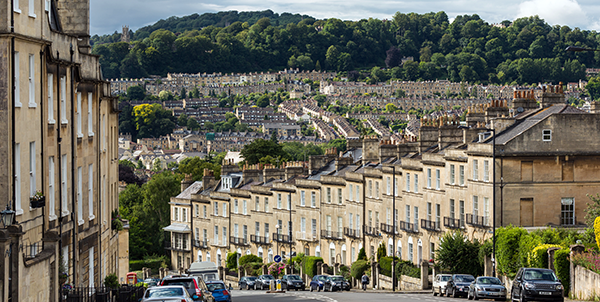
Bath. Picture: Diliff/CC BY-SA 3.0 licence
The South West of England region covers the counties of Cornwall, Devon, Somerset, Dorset, Gloucestershire, Wiltshire and Bristol. It has traditionally been a key battleground of UK elections. In 2017, the Conservatives won 47 of the 55 seats here, with Labour winning seven and the Lib Dems just one. While the Conservatives dominate, the Liberal Democrats will be hoping to re-gain some of the seats they lost in 2015. They will be buoyed by the fact they finished second place in 14 seats here in 2017. However, most constituencies in the South West voted for Brexit, and the Brexit Party are not standing in Conservative-held seats, which could blunt the pro-Remain parties’ gains.
After the Lib Dems’ electoral collapse in 2015 (see Figure 1), the net change in seats was fairly low in 2017, but four seats did switch party, with Labour winning Bristol North West, Plymouth Sutton & Devonport and Stroud from the Conservatives. The Liberal Democrats took Bath from the Tories.
Map of South West 2017 general election results, with key seats labelled
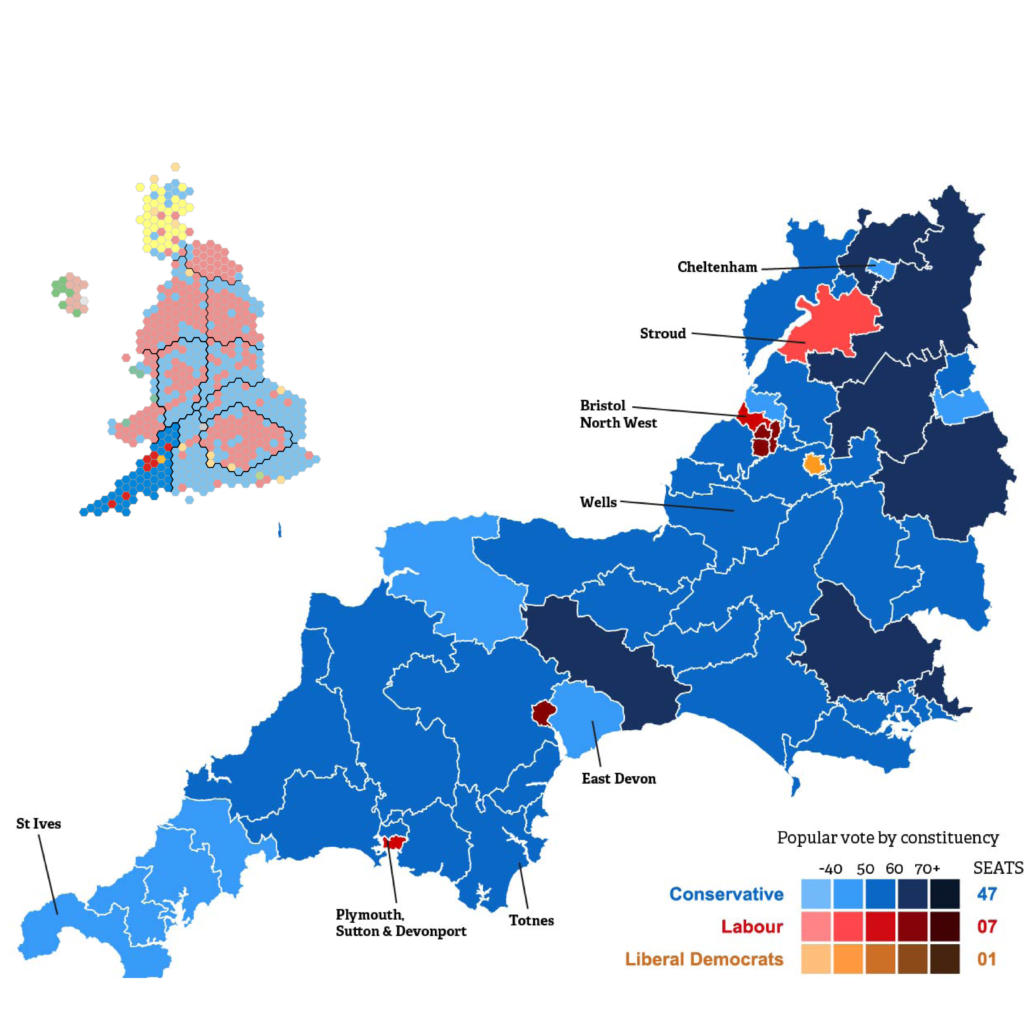
Source: Adapted from map by DrRandomFactor & Ch1902 /Wikipedia. Key constituency contests for 2019 labelled.
For all seats in the region, you can find full details of the candidates standing in 2019 and their social media links at DemocraticDashboard.com. It also gives complete results from the 2017 general election, estimated 2016 EU referendum results and details about the constituency so you can best make up your own mind how to vote.
The estimated constituency results for all seats in the South West in 2019, and regional vote shares given in figures 1 and 2, come from YouGov’s large MRP poll published on 27 November and are the best available at the time of writing. A sample of 100,319 people was polled across the UK, and used, along with demographic and other data, to create estimates for each constituency.
Figure 1: Number of seats won by each party at the last three general elections in the South West, and latest estimates from YouGov polling, 27 November
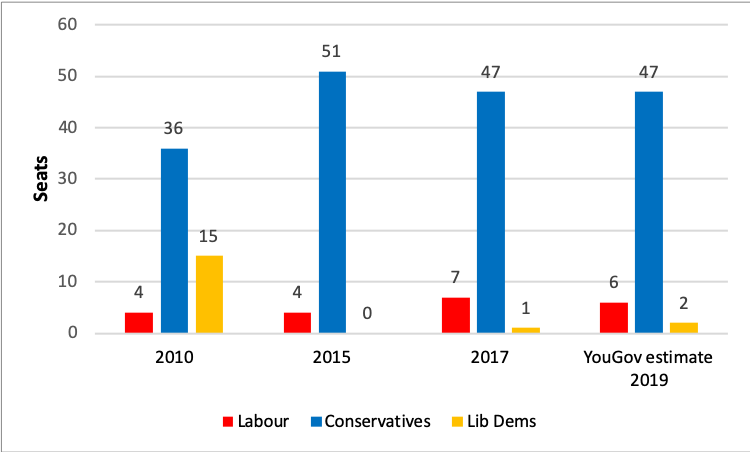
Note: 2019 figures from YouGov MRP seat estimates, 27 November, 2019.
Figure 2: Parties’ shares of the votes in the South West at the last three general elections, and estimated vote share 2019 (polling YouGov, 27 November)
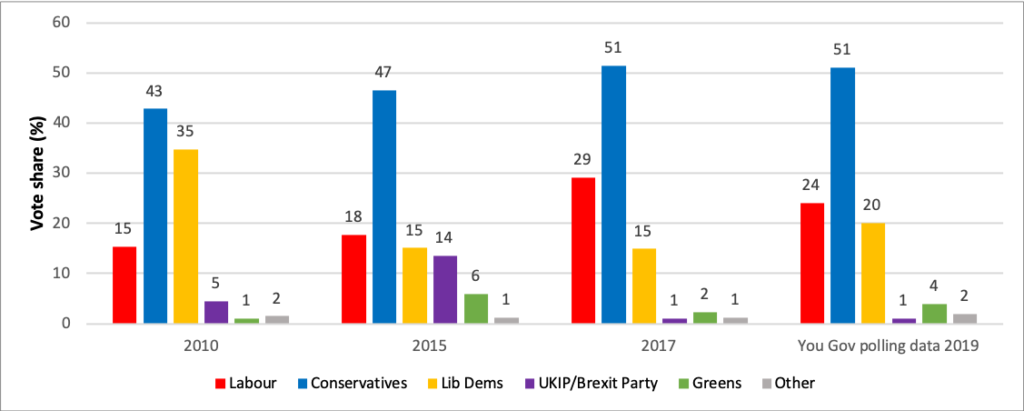
Note: YouGov/MRP data for London from Benjamin Lauderdale and Jack Blumenau for YouGov, 27 Nov national MRP poll.
On latest polling, the picture in England and Wales is generally that of significant numbers of Labour seats going Conservative. In the South West this trend is limited by the sheer dominance of the Conservatives here. First we look at the seats that the Tories are targeting, followed by the seats the Liberal Democrats will want to reclaim. The Greens are also campaigning hard in some constituencies, and East Devon is of interest for its high-profile Independent.
Seats Labour is defending against the Conservatives
The only Conservative gain forecast in the South West by YouGov is Stroud, which Labour held between 1997 and 2010, and which they retook (with the same candidate, David Drew) in 2017. Labour’s task of defending a majority of just 1.1% is complicated by the presence of a strong Green campaign, with South West MEP Molly Scott Cato standing here, and the Lib Dems standing down in favour of the Greens. However, all Remain tactical voting sites recommend a Labour vote here.
The other Conservative targets are Bristol North West, and Plymouth, Sutton and Devonport, which were captured by Labour in 2017. On current polling both remain Labour. Plymouth, Sutton and Devonport had a narrow majority for Leave in the 2016 referendum, but the Brexit-supporting vote may be split as high-profile Brexit Party candidate Ann Widdicombe (who was reputedly offered a government role to induce her to step down) is standing. The former Conservative MP will be hoping to better UKIP’s 2015 vote share of 11%, which could be enough to split the Leave vote and help Labour retain the seat.
Target seats for the Liberal Democrats
The seats where Lib Dem hopes will be highest include Bath, which was re-captured by the party in 2017 and will likely remain in the yellow column this time, and Cheltenham, where a strong Remain vote and a Unite to Remain alliance will boost the party’s hopes of a gain. In Cheltenham, YouGov’s estimate places them neck and neck with the Conservatives. St Ives is currently the most marginal seat in the region, and was held by the Lib Dems until 2015. Their former MP, Andrew George, is standing here again. On a good night Jo Swinson’s party could also make inroads into previously held seats like Wells, Chippenham and Taunton Deane. In all these seats the Lib Dems will be aided by ‘Unite to Remain’ alliances, meaning no Green party is standing.
Slightly behind in terms of polling estimates, is Totnes, where the former Conservative MP for the seat Sarah Wollaston is standing for the Lib Dems, having defected in early 2019, initially to Change UK and then the Lib Dems. Again, the Greens are standing aside, but YouGov currently place her 19% behind the Conservatives (31% to 50%), though the poll may not pick up some local factors like candidate profile.
Of the Unite to Remain seats where the Greens are standing instead, they are expected to perform strongly in Bristol West. YouGov’s model estimates their support to be 20% in the constituency, which would still put them in a distant second place behind Labour.
An Independent challenger
The region also includes one of the country’s most unusual contests, in East Devon, where the independent candidate Claire Wright is the main challenger to the incumbent Conservatives, whose candidate Simon Jupp replaces former MP Hugo Swire. An independent local councillor, Wright first stood in the constituency in 2015, winning an impressive 24% of the vote, and increased her vote share in 2017 to 35%. Wright supports ending austerity and a confirmatory referendum on Boris Johnson’s deal – in which she will campaign to Remain in the European Union.
While not an official ‘Unite to Remain’ candidate, Wright is endorsed by all the Remain-focused tactical voting sites, and will be hoping that her pro-referendum position and opposition to austerity will win over Labour and Liberal Democrat voters keen to oust the Conservatives locally. Indeed, while YouGov’s MRP model estimates that the Conservatives will win the seat with 47% of the vote, it estimates that Wright is in close second place with 41%. If elected, she will become the first independent MP to be elected (for a British constituency) at a general election since 2005.
Figure 3: The most marginal seats in the South West (by % vote) in 2017
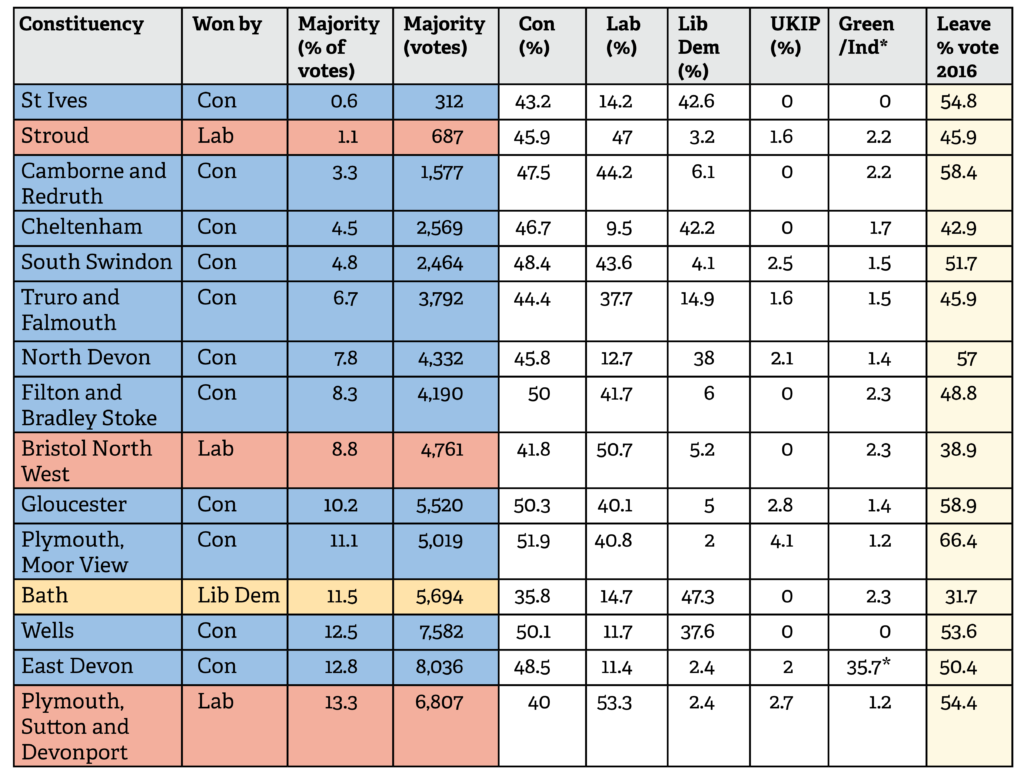
*Claire Wright, Independent
Note: The Leave % for each the 2016 Brexit referendum by constituency (and mentioned throughout this article), are Chris Hanretty’s estimates. You can also find these for each constituency (including those we don’t discuss), along with general election results at DemocraticDashboard.com.





 Democratic Audit's core funding is provided by the Joseph Rowntree Charitable Trust. Additional funding is provided by the London School of Economics.
Democratic Audit's core funding is provided by the Joseph Rowntree Charitable Trust. Additional funding is provided by the London School of Economics.
Amazed that arguably, the battleground that will throw up the most surprises, Yorkshire and Humber – is still to be analysed. Saving the best until last??!!
Thanks for your interest. Yes, watch this space. Lots of seats forecast to change hands there.
Very interesting on East Devon: but I think the last claim is open to challenge as Lady Sylvia Hermon was elected several times as an independent in North Down?
Of course! Will amend. Thank you